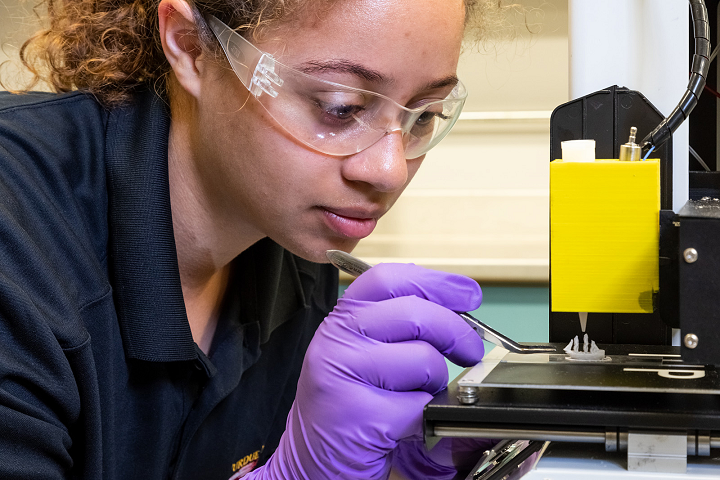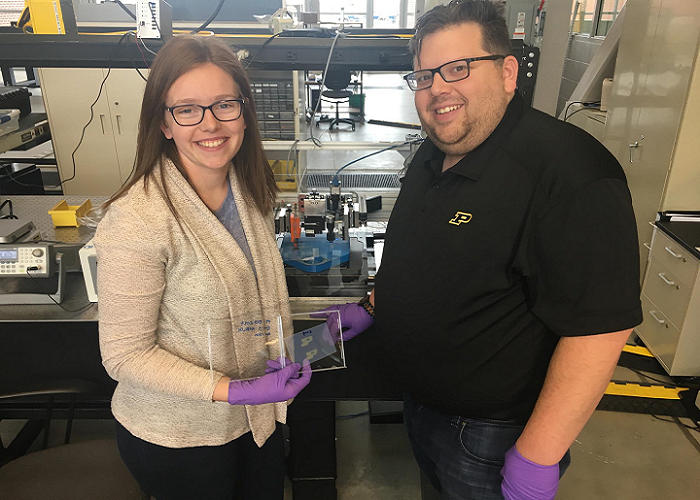Purdue Researchers Form Startup for the 3D Printing of Energetic Materials
Energetic materials are a class of material that contains high amounts of stored chemical energy that can be released, and they are used in everything from airbags to explosives. Last year, a team of researchers from Purdue University used 3D printed energetic materials to create a mini shock wave, and have since continued their work with these unique materials.
The researchers can safely 3D print energetic materials, featuring fine geometric features, for less money, at greater speeds. Now, Jeffrey Rhoads, a professor in the university’s School of Mechanical Engineering, has teamed up with several other colleagues, including former Purdue research assistant professor Emre Gunduz, to start a faculty-owned startup focused on making the energetic materials, like propellants, solid rocket fuels, and pyrotechnics, along with the 3D printers that can produce them.
Rhoads is now the COO of Next Offset Solutions, with Gunduz, now a professor at the Naval Postgraduate School in Monterey, California, as its CTO. The startup makes its energetic materials with a process – patented with help from the Purdue Office of Technology Commercialization – that allows the 3D printer to produce viscous materials, which have a clay-like consistency and can be difficult to extrude. The method makes it possible for the team to precisely, and safely, deposit the energetic materials.
Rhoads said, “It’s like the Play-Doh press of the 21st century.
“We have shown that we can print these energetic materials without voids, which is key. Voids are bad in energetic materials because they typically lead to inconsistent, sometimes catastrophic, burns.”
According to Rhoads, the startup’s 3D printer doesn’t use any solvents to lower the viscosity, which makes the process faster, more environmentally friendly, and less expensive. Additionally, the 3D printer is also much safer due to a remote control feature.
“You don’t have to have a person there interfacing with the system,” Rhoads explained. “That’s a big advantage from the safety standpoint.”

Monique McClain, a doctoral candidate in Purdue’s School of Aeronautics and Astronautics, demonstrates how it’s possible to 3D print extremely viscous materials.
The 3D printer functions a lot like more conventional 3D printers, with the exception of how it extrudes the highly viscous materials. High-amplitude ultrasonic vibrations are applied to the 3D printer’s nozzle, which lowers the friction on the nozzle walls and allows for more precise flow control of the material.
While Next Offset Solutions is mainly focused on producing energetic materials, it’s not adverse to further applications, other Purdue researchers have already used the startup’s novel method to 3D print things like personalized drugs and biomedical implants. For instance, because its 3D printing material has already been qualified by the departments of Defense and Energy, the startup hopes to provide its technology and products to the departments and their contractors.
 The startup is also focusing on additional advanced evaluation, research, development, and testing in the 3D printing and energetic materials space. But its original research definitely aligns with the university’s Giant Leaps celebration as part of its 150th anniversary, which celebrates Purdue’s “global advancements in health.”
The startup is also focusing on additional advanced evaluation, research, development, and testing in the 3D printing and energetic materials space. But its original research definitely aligns with the university’s Giant Leaps celebration as part of its 150th anniversary, which celebrates Purdue’s “global advancements in health.”
Purdue researchers have published several papers focusing on 3D printing energetic and viscous materials in the Additive Manufacturing journal, including:
- “3D printing of extremely viscous materials using ultrasonic vibrations“
- “Additive manufacturing of multifunctional reactive materials“
- “Selectively-deposited energetic materials: A feasibility study of the piezoelectric inkjet printing of nanothermites“
Take a look at the video below to see the viscous material 3D printing process for yourself:
What do you think? Discuss this work and other 3D printing topics at 3DPrintBoard.com or share your thoughts in the Facebook comments below.
[Source/Images: Purdue University]Subscribe to Our Email Newsletter
Stay up-to-date on all the latest news from the 3D printing industry and receive information and offers from third party vendors.
Print Services
Upload your 3D Models and get them printed quickly and efficiently.
You May Also Like
AMT Shakes Up 3D Printing Market with Affordable, High-Performance Post-Processing Consumables
Additive Manufacturing Technologies (AMT), a global leader in automated 3D printing post-processing, is launching a new line of consumables that promises to significantly reduce operational costs for additive manufacturing users....
The Bambu Lab 3D Printing Platform… or Trapdoor?
Bambu Lab began as a completely closed 3D printing system, where the printer, software, and materials all functioned well but were exclusively from the company itself. This approach mirrored Formlabs,...
2025 Renault 5 E-Tech Electric Is Latest Car with 3D Printed Accessories
Due to the required numbers, additive manufacturing (AM) has struggled to make significant inroads into vehicle interiors in meaningful numbers—at least as far as public knowledge is concerned. Typically an...
BMW Completes Project to Automate Plastic 3D Printing
After a three-year journey to efficiently scale polymer 3D printed part production, the POLYLINE project has concluded. This endeavor, headquartered at BMW’s Additive Manufacturing Campus, pooled the expertise of EOS,...
































